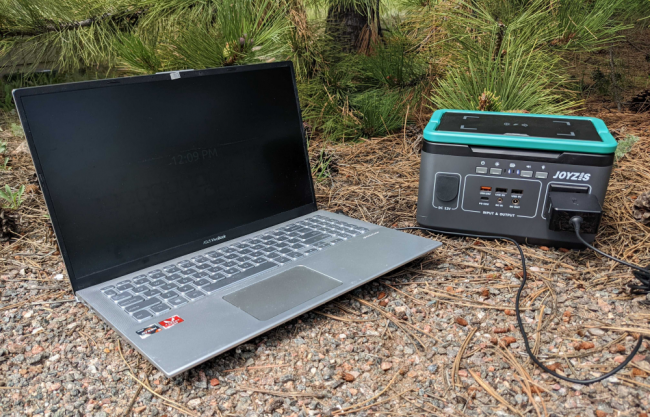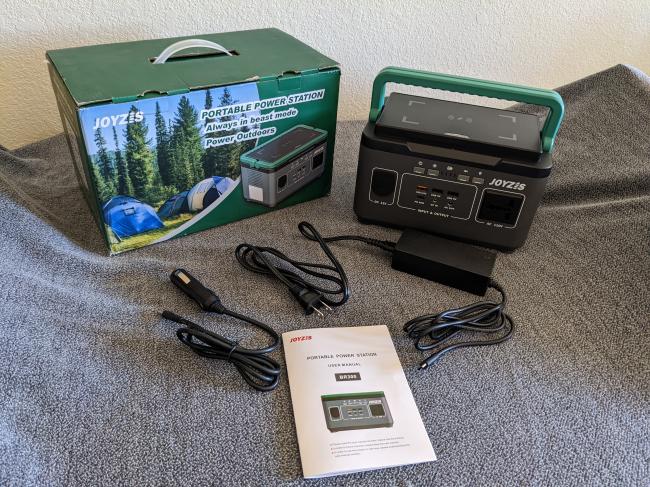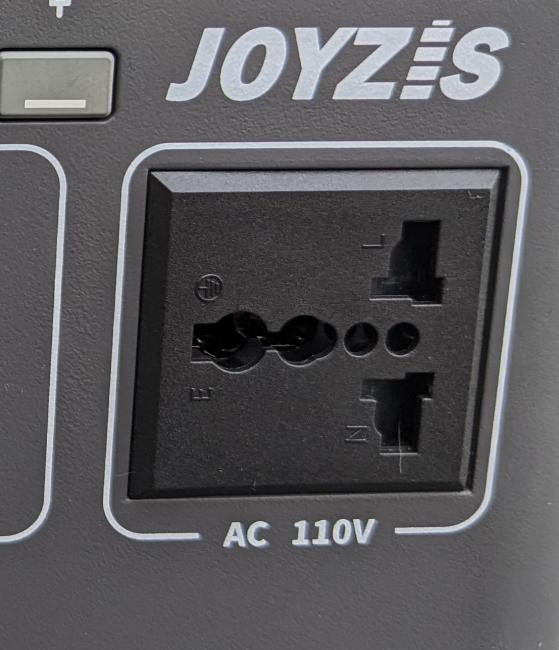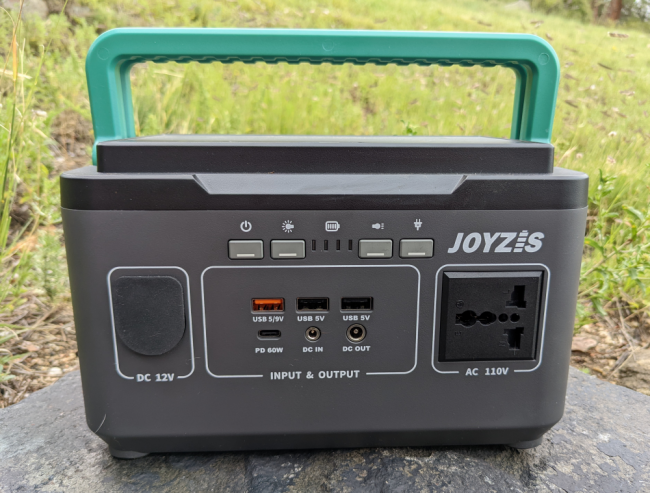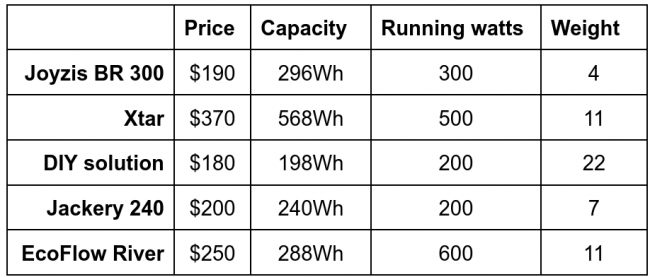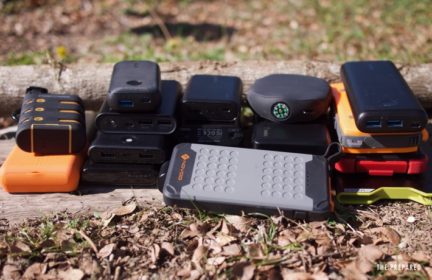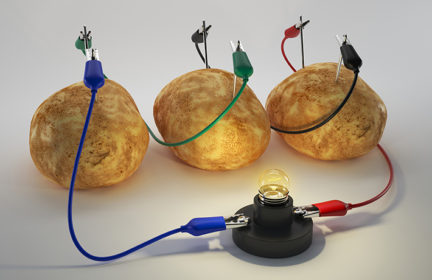Review: Joyzis 300W battery pack. A lightweight powerhouse
The Good:
Where this little unit shines is that it only weighs 4 pounds making it very easy to travel with or move around if you had restrictions on how much you could lift. I loved the recessed handles that can come up for easy carrying, or be stowed down for a flat surface and expose the wireless charging pad on top.
The Joyzis has a battery capacity of 296Wh, which is about 8X as much juice as a portable power bank, plus you get the ability to power smaller wall outlet devices like a laptop or CPAP machine. With this capacity, I was able to power my work laptop and cell phone solely off of this battery pack for 2.5 days. And impressively, it was able to keep a portable fridge powered for two full weekends of camping.
In another review, the Xtar power station for some reason caused the keyboard and mouse to glitch when I connected my work-from-home setup to it. The Joyzis however was able to power all of this (laptop, monitor, keyboard, mouse, speakers, and USB hub) flawlessly.
Joyzis offers a one-year warranty with this unit, but you can extend that to two years if you register your product with them. If you want this extended warranty, go to this website or email them at joyzis(at)afterservice.vip. Ignore the service.joyzis(at)outlook.com email address on the sticker on the bottom of the unit, I wasn’t ever able to reach a human when contacting them through this address.
This power station comes with a 60W USB C wall charger which will charge from 0-100% in about 5-6 hours, and a car cigarette charger for topping it off on a road trip.
I was worried when I received this unit that they sent me a European version because the outlet is unlike any that I’ve seen here in the States, but both two prong and three prong US plugs still work in this along with various types that seem to be used in other countries. Pretty neat!
The Bad:
Over a year ago The Prepared was sent over a sample power station but during our testing, the unit suddenly stopped being able to be charged. We contacted the company and they sent us over a replacement and this review is on that second unit.
Looking through Amazon reviews, a large percentage of people have received their unit, lifted it out of the box, and the entire top pops off and is broken. So there are some quality control issues here. The good thing though is that most of the reviews say that they contacted the company and were instantly sent a new unit.
A missed feature on the Joyzis is that you cannot charge this unit and power devices off of it at the same time. So if you had it charging by a solar panel during an emergency, you have to wait until it is done if you want to plug things into it. Also, a bummer if you wanted to use this as a UPS (uninterruptible power supply).
Something annoying that I found with the unit is that the buttons stick out quite a bit and the power button is easily clicked on with the slightest touch, making this a poor choice to throw in a bag. All of the other buttons need a three-second hold to activate, I don’t know why the ON button couldn’t have this ability as well. Funny enough you do need to hold that power button for three seconds to turn off the unit.
Instead of using a display like most power stations, which give you valuable information like battery percentage, load, and how much time is left to charge, the Joyzis opted to use four bright LED bars. But this simple display of remaining battery capacity still left me wondering how much each device was draining and if I was close to overloading the unit or not.
The Joyzis does utilize a PWM charge controller that is inferior to MPPT units in higher-end power stations. It gets the job done, but is not as efficient.
Comparing this to other small power stations:
When comparing the Joyzis to the other two power stations I have had my hands on before, the Xtar is nice in that it has recessed buttons that require a three-second hold time to activate, twice the capacity, and can handle surge watts up to 1000, but at twice the cost of the Joyzis.
In a previous post, I made a power station and while it was a fun project, for the same price, the Joyzis has an additional 100Wh of capacity and weighs a fifth of the DIY option. The Joyzis is small enough to fit inside the 50 caliber ammo can that I used for that DIY project, which could be a nice container to store cables and keep it more protected and waterproof.
I haven’t held the Jackery Explorer 240, but comparing specs, the Joyzis is cheaper and lighter, has more capacity, two additional USB ports, wireless charging, and is a much smaller profile. Jackery however, is a much more trusted company and with the large number of quality control issues that Joyzis seems to have, I would pick Jackery to get me through a disaster over Joyzis.
I would love to try out an EcoFlow product as they are known to be very high quality. The River model is similar to the Joyzis in capacity but has a much more powerful engine under the hood allowing for 600 running watts and 1200 surge through 3 AC outlets compared to Joyzis’s 1. However, that amount of power output and ports is overkill in my opinion for a sub 300Wh capacity power station. It just doesn’t make a ton of sense to run 600 watts of devices through a 288Wh station and only have it last for 20 minutes or so.
Summary:
If you want a lightweight power station to keep phones, tablets, and a laptop topped off during a short power outage or on a camping trip, this is a cheap option that can fulfill those needs.
The Joyzis BR 300 power station is listed for $280 on Amazon, but there is always a $90-$150 off coupon right under the price tag as long as you click it.
-
Comments (4)
-
